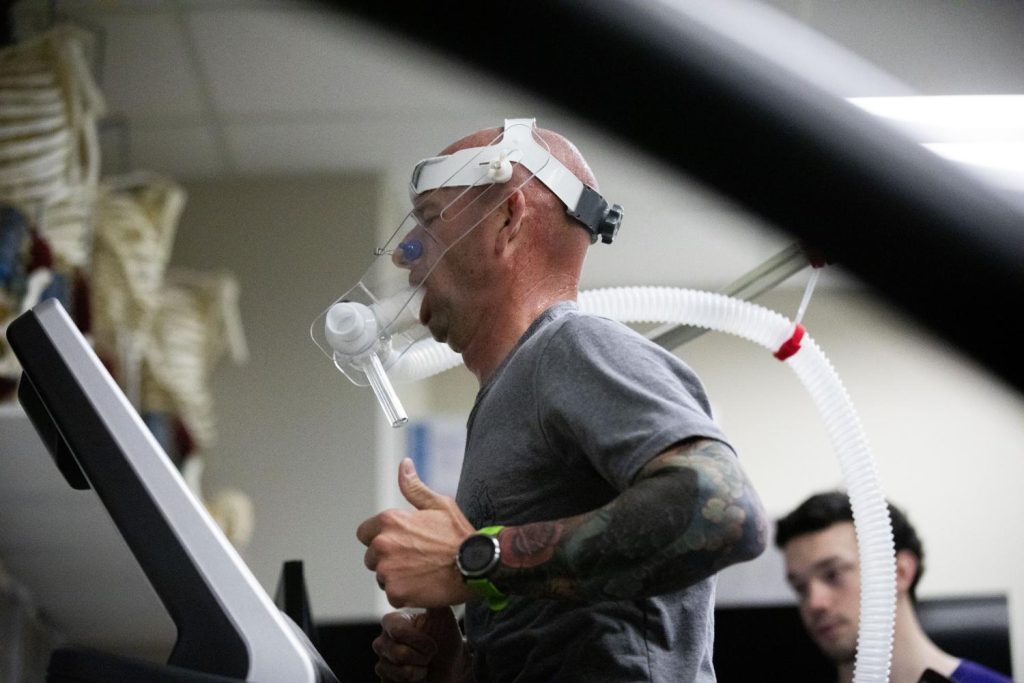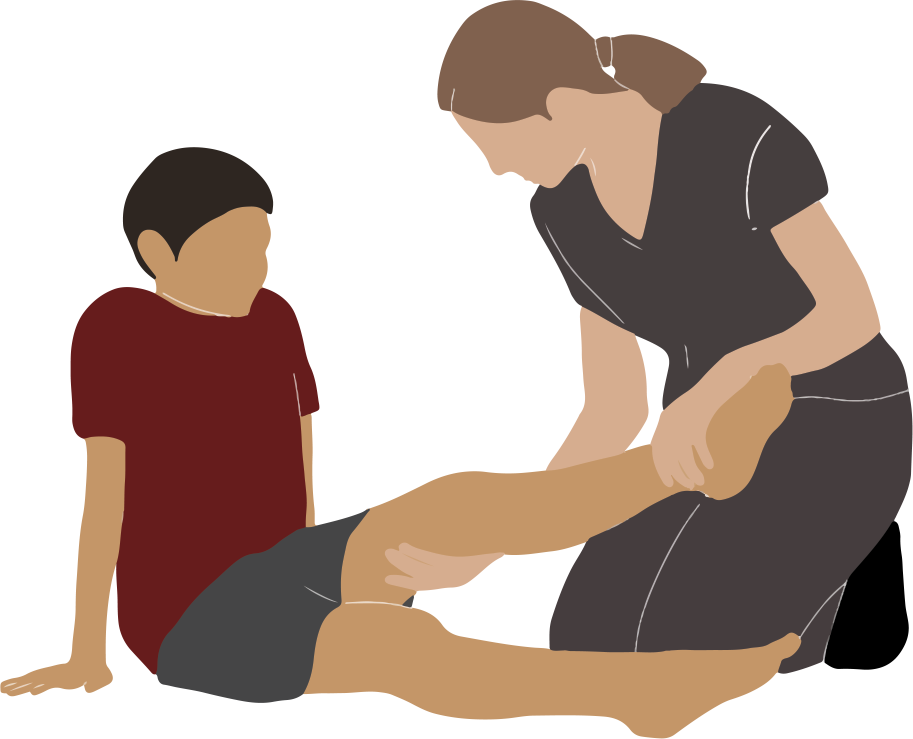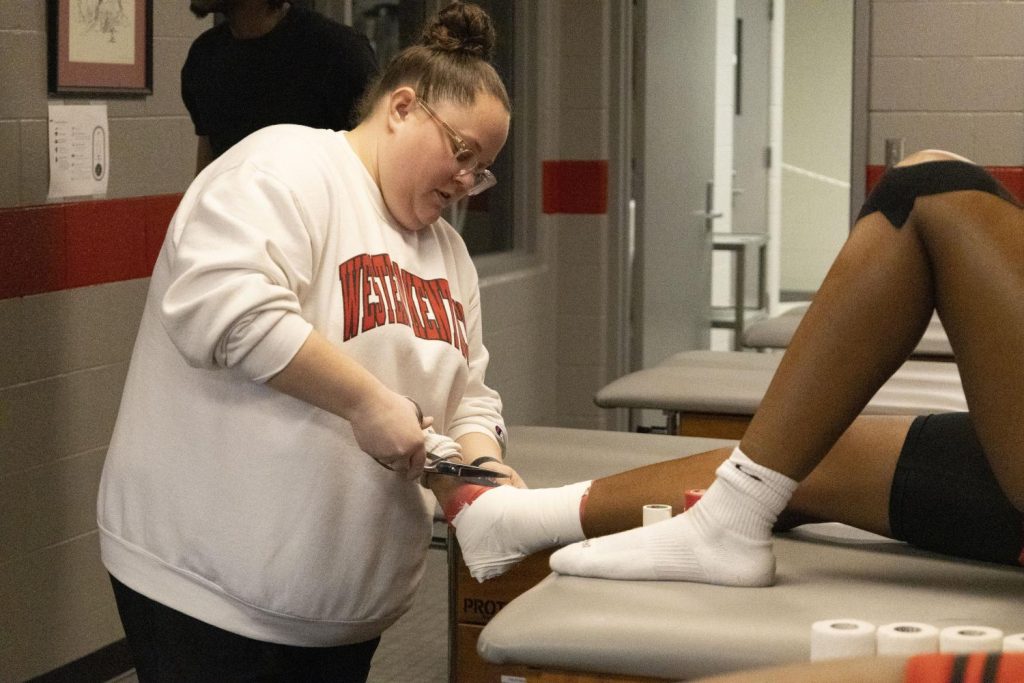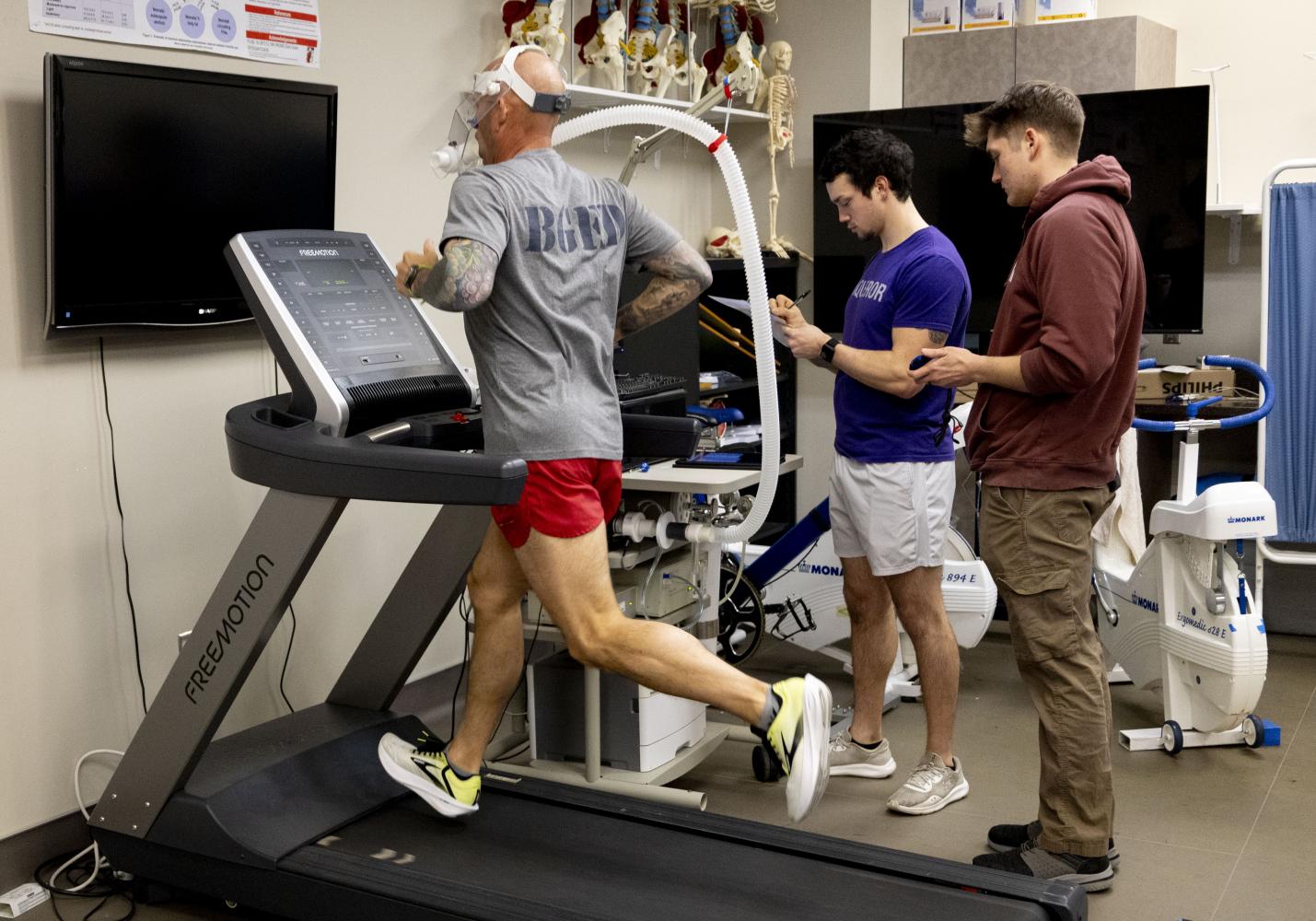Under the stands of Houchens-Smith Stadium is a maze of classrooms and labs where students learn the science behind exercising. This is the home of WKU’s exercise science department.
Audrey Clark, a junior exercise science student from Hendersonville, Tennessee, said she wants to become a physical therapist.
“I was a dancer for a long time, so that really started my fascination with how the human body works,” she said.
She said she took an anatomy class in high school and decided to pursue the field. Clark said after she gets her degree, she would like to study for a doctorate in physical therapy.
“It’s a long haul, but I’ve shadowed in the PT world, and I really enjoyed what they do and the lifestyle they can have,” Clark said. “I’ve always wanted to find a career that is interesting to me that I would enjoy daily that’s challenging for me.”
Clark said she is most interested in working with children.
“Kids are so resilient, and they’re so fun, and you have the opportunity to make movement and rehab more fun if you make it into a game,” she said.
Clark said that there are many different settings that physical therapists can work in, such as working in a hospital or traveling. She said that it is a good career for those interested in athletics, since most professional teams have physical therapists.

Firefighter Kevin Lashley takes a VO2max lab test at Houchens-Smith Stadium on Wednesday, Feb. 21. The VO2 test is done on a treadmill and starts at an easy pace; as the test goes on, the intensity increases for 10 to 20 minutes.
She said that communication is important to be a good physical therapist, as well as adaptability and creativity. Since patients often have different abilities and resources, she said it is important to tailor treatments to the patient.
“There’s not really a one-size-fits-all for exercise,” she said.
Clark said that in the classroom, professors often talk about the “healthy, perfect athlete” but she said an important part of exercise science is to adjust treatments based on each patient’s skills.
“We’re not all these perfect cookie-cutter types of people that we study in books,” she said. “You have to take what you know and apply it to the person that’s actually in front of you.”
Clark said she has been tutoring since fall of 2022 through The Learning Center on campus. Currently, she said she tutors a peer-assisted study session class for human anatomy.
“I know the stuff that’s covered in that class really, really well because I’ve been talking about it ever since I took the class two years ago,” she said.
She said that she learns best by teaching other people, and this review will help her remember material for physical therapy school. She said she creates documents and games, such as Kahoot, to help students study for exams.
Casey Robinson, a senior exercise science major from Glasgow, said she is interested in physical therapy because her mother was a nurse, and she has volunteered at a summer camp to help children with disabilities.
“I felt like I needed to volunteer for that so I could get an idea of what I wanted to do and just get involved in the community,” she said.
Robinson said there were speech therapists, occupational therapists and physical therapists at the summer camp, which triggered her interest in physical therapy. She said after that experience, she started a job where she shadowed a physical therapist.
“I loved every aspect of it, and I’ve been pursuing it ever since,” she said.
Robinson said she has been accepted into WKU’s physical therapy doctorate program and will be starting the program this summer. She said she would like to specialize in neurologic physical therapy, helping stroke victims or Parkinson’s Disease patients.
“Working as a tech, I’ve seen stroke patients, and it just kind of plays on your heartstrings,” she said. “Somebody who wasn’t able to get out of a chair, you can retrain them to learn how to do that again so they’re going to be able to live their life to the fullest again.”
She said she would also like to work in orthopedic rehab, helping people with injuries or people who have lost mobility because of arthritis.
“I want to help them; I want people to be able to do what they love,” Robinson said.
Robinson said that it is important for physical therapists to be able to work with people.
“You’re able to understand that people have good days; people have bad days; but you’re just there to help them,” she said. “You just want to be that support system for them, no matter what they’re going through.”

Robinson said the exercise science program is community-oriented and that knowing people is an important part of the career.
“You want to make sure everybody in the community is doing well and everybody’s healthy,” she said. “Being able to build the relationships with your community makes it easier to help them become healthier.”
Robinson said that WKU’s exercise science professors have been integral to her education.
“Sometimes people think that it’s intimidating to have a relationship with your professors and stuff, but I truly believe that all the professors in the exercise science program do the best to have a relationship with their students,” she said.
She said that professors encourage cooperation with other majors and clubs, such as the Pre-Physical Therapy Club.
“It’s not us against them,” Robinson said. “It’s everybody doing stuff together.”
Robinson is the president of the exercise science club, which she said includes roughly 100 students. She said her role is to get more people in the major involved in the club.
“We’re all in this field to help people, obviously,” Robinson said. “Why would we not go ahead and get started in college and get used to being involved in the community?”
Robinson said the club has volunteered with a Down syndrome walk and at Village Manor, an assisted living facility in Bowling Green. She said the club also participates in Dance Big Red and other fundraisers.
Robinson said she tore her ACL in October while playing intramural volleyball with the club and that she is receiving physical therapy for that injury.
“I’m actually getting the perspective of getting that therapy, and I love it even more,” she said.
Sarah Scali, an assistant professor of exercise science, said that exercise science is a planned stress on the body and that exercise scientists monitor how the body responds to that stress.
Scali said that she tried studying biology, psychology and physical therapy before finding exercise science.
“This takes two things that I love, which is movement and exercise, and science,” Scali said. “What I love most about exercise science is that it’s completely relevant to anybody.”
Scali said that WKU’s exercise science major is meant to be broad, so students have several career options. She said that exercise science students take a practicum and an internship.
“They come back with some more respect for the field because of how much interaction they get with patients and clients,” Scali said.

Assistant athletic trainer Rebecca David cuts bandaging tape for a female basketball player in Diddle Arena on Wednesday, Feb. 21 to help her recover for her next game.
Scali said that exercise science faculty and graduate students analyze data for WKU’s Lady Toppers soccer team, although she would like to help with more sports in the future. She said the athletes wear heart rate monitors, and the faculty use data they collect to find ideal practice and rest days.
“We really want to try to open that up more to students to help out with research and get their paws wet with that kind of data analysis,” Scali said.
Scali works with the exercise science Living Learning Community, founded in 2021, according to the WKU website. She said 24 freshmen a year live together in Regents Hall and take some classes together.
Scali said anatomy is one of the harder classes students take as freshmen or sophomores, and that all members of the LLC take the class together.
“If they can develop that friend base, that study group base, they might be able to be more successful,” Scali said.
Campbell Bush, a junior exercise science major from Bowling Green, said he was a member of the LLC as a freshman.
“I always just knew I had people I could go to if I had questions, or people knew they could come talk to me if they needed help with anything,” he said.
Bush said he first became interested in exercise science because of treatment for a back injury he sustained at basketball practice in eighth grade.
“I went to physical therapy, and the guy had it figured out in, like, five or 10 minutes,” Bush said. “So, I knew physical therapy was something I wanted to go into.”
Bush said he works at BenchMark Physical Therapy in Bowling Green as a technician. He said his work includes doing laundry, cleaning, organizing and helping physical therapists.
“I love it,” he said. “I can really see myself helping people in that field.”

Whitley Stone, an associate professor of exercise science, co-taught a study abroad program in Hawaii last summer. She led the program with Stacey Forsythe, a WKU sports management professor who taught students about tourism. She said that students got to learn how the body responds to different environments, such as scuba diving or mountain hiking.
Stone said that exercise science both focuses on anatomy and what is happening inside of the body, as well as how the body interacts with the environment through exercise.
“Any stress on the body has an inherent risk, but all the benefits of exercise outweigh the risks for the most part,” Stone said.
Stone said she had a student in her class with electrical and functional abnormalities in their heart that was detected in class.
“That was something you have to be ready for and know how to respond to that,” Stone said.
Stone studied physical education at Lee University in Cleveland, Tennessee, and took a class called exercise physiology, which led her to pursue exercise science.
“It’s actually a class I teach now, so it’s fun that it came full circle,” Stone said.
She said she knew she wanted to teach at a college since exercise physiology is not taught at lower levels.
“I didn’t love the K-12 setting,” she said. “They didn’t get my jokes.”
Stone said that students and faculty usually either like the exercise side or the science side of exercise science.
“You don’t always find students who love both,” Stone said. “If I’m honest, I like the science more than the exercise.”
Stone said the majority of exercise science students plan on continuing to graduate school since many fields in exercise science require graduate degrees. She said that exercise science graduates can work with factories to prevent repetitive stress injuries. She said that those in exercise science strive to tell patients and students about the benefits of exercise.
“Most of them are centered around helping other people and getting other people from the couch to a movement-centric life,” Stone said.


